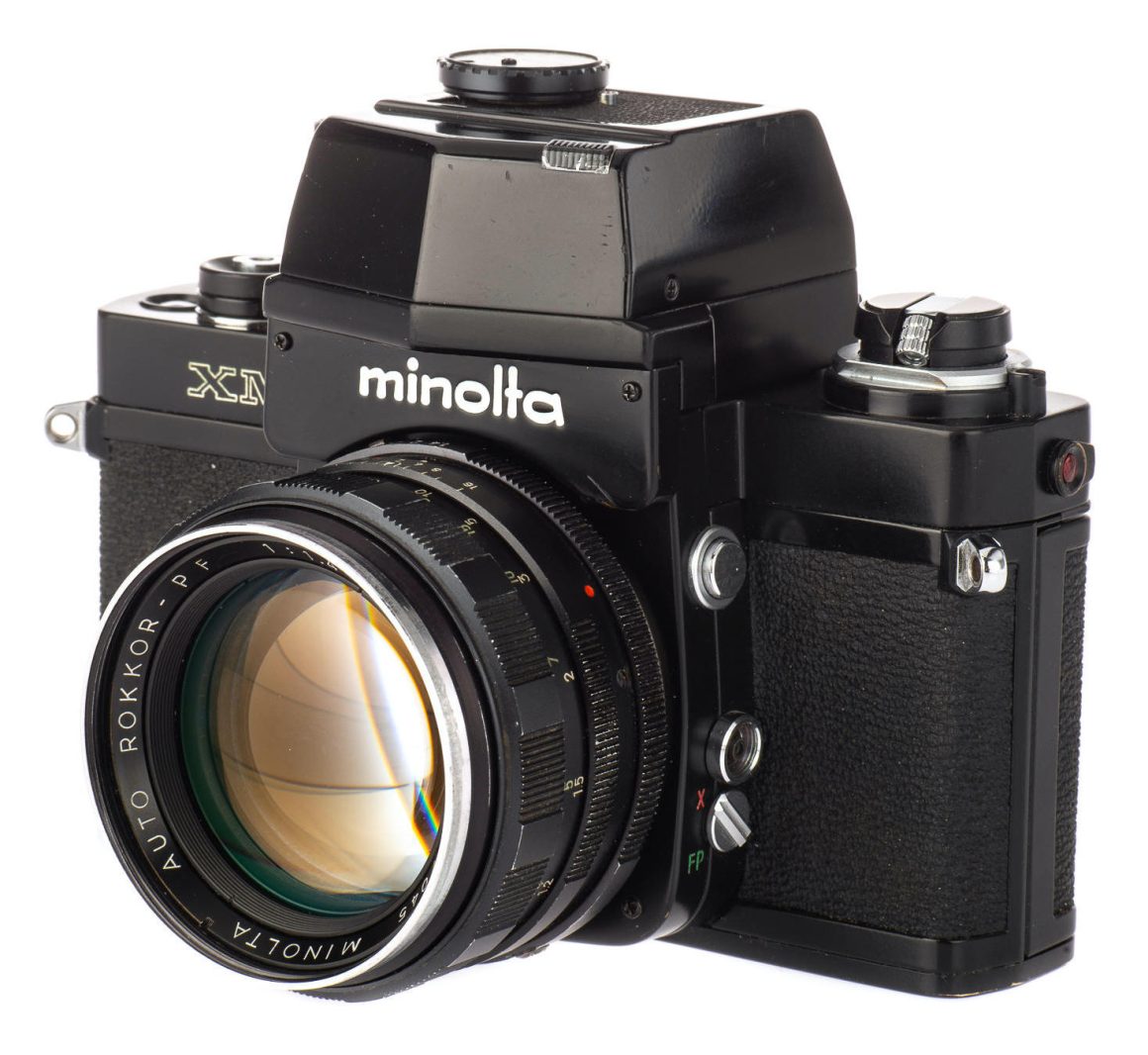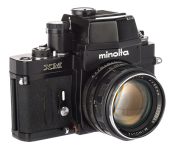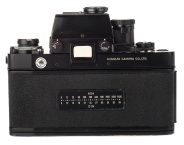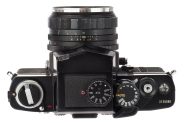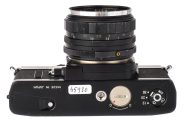Minolta XK
aka Minolta X-1
aka Minolta XM
35mm MF film SLR camera
Specification
| Production details: | |
| Announced: | April 1973 |
| System: | ● Minolta SR (1958) |
| Format: | |
| Maximum format: | 35mm full frame |
| Film type: | 135 cartridge-loaded film |
| Mount and Flange focal distance: | Minolta SR [43.5mm] |
| Shutter: | |
| Type: | Focal-plane |
| Model: | Electronically controlled |
| Speeds: | 16 - 1/2000 + B |
| Exposure: | |
| Exposure metering: | Through-the-lens (TTL), open-aperture |
| Exposure modes: | Aperture-priority Auto |
| Manual | |
| Physical characteristics: | |
| Weight: | 670g |
| Dimensions: | 144.5x84x48mm |
Manufacturer description #1
Minolta's XK has the potential and built·in versatility to make it the precisely correct camera to use in any situation. But the most complete XK uses the Auto Electro Finder, providing automatic exposure. Just set the lens opening, and the shutter speed is controlled and set electronically.
Exposure Nerve Center
The XK's electronic exposure system is contained in the Auto Electro Finder. The Contrast Light Compensator meter using light sensitive CdS cells is located in the finder, measuring light through-the-lens at full aperture.
Also built into this finder is all the circuitry necessary to electronically time and release the shutter. Special circuits calculate the film sensitivity, lens aperture, plus other critical factors, combining these with CLC light measurement determining exposure. Now complete, this information is held in the finder's electronic IC memory. During the actual instant of exposure, the memory circuit releases the precise current required to the electronically controlled shutter. These impulses travel along internal micro circuits of the XK body to the shutter release mechanism, 3 timing shutter speed precisely.
The entire process takes place in a fraction of a millisecond allowing continual change of exposure inputs, right up to the instant the mirror snaps up and the exposure is made.
Electronic Shutter Speeds
Perfectly-timed shutter speeds in the XK extend from 16 full seconds to an incredible 1/2000 of a second, a speed fast enough to capture anything your eye is capable of tracking. Throughout this entire range, all speeds are electronically accurate.
When the camera is set in automatic mode, there are no restrictions whatsoever. Electronic stepless speeds then start at 4 seconds and run to the top speed of 1/2000 of a second for pinpoint correctness at any speed within these two extremes. Shutter speed is free to vary, unburdened by the normal incremental limitations imposed by most mechanically adjusted shutters.
The advantages of electronic timing are far-reaching, and you will discover them in situations where handling speed and exposure accuracy are of the essence. This is when the XK is at its ultimate best, and this is when you'll appreciate it most.
Inside the Finder
Displayed inside the finder are all things necessary to monitor exposure: shutter speed scale, the aperture at which the lens is set, and appropriate indicators. Also visible is the Light-Emitting-Diode exposure warning signal which pulsates when exposure conditions fall below the meter's lower operating limits.
The finder is unusually bright from side to side, corner to corner, and presents a complete, clear view of the subject area. Even most eyeglass wearers will be able to examine the entire field of view without averting their eye.
More About the Auto Electro Finder
For photographic effect, a thumb controlled Auto Exposure Override Control may be engaged. This control makes it possible to under or over-expose a picture a maximum of plus or minus two EV by continuously varying the shutter speed. If, for example, the correct exposure indicated is 1/125 then the speed with the override could vary from 1/30 to 1/500 as you prefer.
In addition to completely automatic operation, the Auto Electro Finder also allows you to set exposure by using the conventional match needle method. These speeds, too, are electronically controlled for exact timing.
A unique system is used to activate the Auto Electro Finder's exposure control systems. Called Auto-Senswitch, the strip on the XK body responds to the touch of your hand, switching on the finder as soon you grasp the camera, and shutting it off when the camera is released. An auxiliary switch, located on the finder, is used when the camera is not hand held.
Titanium Shutter Curtains
In addition to electronic control, the XK shutter is uncommon in still another way. The curtains themselves are constructed of titanium, a special metal that can be rolled to amazing thinness. Titanium curtains are superior in resisting the damaging effects that adverse climates can have on conventional materials. Consequently, the XK's shutter curtains maintain reliability even under conditions of extreme cold, heat and humidity.
Film Advance Lever
For improved handling, the film advance lever rotates on precision bearings. The operation is distinct and even while imparting a genuine feeling of smoothness. Comfortably cushioned, the lever swings out 20° before engagement. A further 110° stroke advances the film and cocks the shutter. Several short strokes or a single stroke will accomplish this function.
Minolta SLR Bayonet Lens Mount
This is the same famous method of mounting lenses that Minolta has used for over 15 years. To guarantee a lasting precision fit, lenses seat against a stainless steel flange. Mounting is accomplished by inserting and twisting the lens 54° in a single, smooth-flowing motion. No other adjustments are required. And simply installing the lens automatically sets the proper metering mode - full aperture through-the-lens with MC Rokkor-X Lenses, or stop down with Rokkors that are not meter coupled.
Multiple Exposures
The procedure for taking accurate multiple exposures is the picture of simplicity with the XK. Merely depressing the film advance release permits the shutter to be cocked without moving the film forward to the next frame. The film remains motionless, holding its position exactly, regardless of how many exposures are made on a single frame.
Film Speed Range
The Minolta XK accepts every type of 35mm film that is now commercially available. The speed range selection extends from ASA 12 to ASA 6400, a choice flexible enough to accommodate every photographic task imaginable.
Oversize, Quick-Return Mirror
The XK's reflex mirror is sufficiently large to avoid image cutoff even when extreme perspectives are desired. This includes very long telephoto shots and highly-magnified close·ups. An independent mirror lock-up switch is also provided. This switch doubles as a depth-of-field preview button.
Batteries and Battery Checker
Only three volts of electric current are necessary for the XK's electronic shutter and exposure control systems. Power is derived from a pair of tiny silver-oxide batteries. The battery chamber is located in the base of the camera to make installing a fresh pair a simple, uncomplicated process. Silver-oxide batteries are generally superior to other types and can be used at lower temperatures.
A battery checker switch with signal light is located on the left side of the camera body.
Battery failure is unlikely. Yet should it occur, there is a mechanism built into the XK which permits you to continue shooting without battery power. You have the option of turning to the non-electronic speed of "X" which is 1/100 of a second ("B" setting is also non-electronic).
X Synchronization
By positioning the shutter speed dial at "X" the shutter synchronizes with electronic flash units at a very rapid 1/100 of a second. This speed is non-electronic and does not require battery power. There is only one receptacle for cord contact flash units. For X or FP synchronization, a switch is provided.
Cordless Flash Contact
For cordless flash units, a "Hot Shoe" contact is incorporated into the XK. Minolta's flash mount accessory holder provides the direct connection for flash synchronization.
XK Standard Lenses
For the XK, you have three, newly-designed standard Rokkor-X Lenses to select from. Each has a new waffle pattern focusing grip for easy handling while shooting.
The most demanding photographer will probably choose the 58mm F1.2. The most popular normal lens is the 50mm Rokkor-X with a maximum aperture of F1.4. An alternative to this would be the 50mm F1.7. Regardless of which basic lens you may prefer, all are made with the same commitment to exceptional optics and all have Minolta's exclusive Achromatic Coating.
Manufacturer description #2
Your Minolta XK is a wide-scope electronic system camera that accepts all Minolta SLR lenses and accessories as well as XK interchangeable finders and focusing screens. It is engineered and built to give you greatest precision; easiest, most convenient operation; and msximum versatility. It gives full information and offers complete control of all camera exposure variables. In automatic operation, the XK will adjust exposure with utmost accuracy electronically, freeing you for more enjoyment or greater creativity.
Manufacturer description #3
TYPE: Interchangeable-finder-type 35mm single-lens reflex with electronic focal-plane shutter
LENS MOUNT: (Standard lenses: MC Rokkor-X 50mm F1.7, 50mm F1.4, or 58mm F1.2). Coupling: For full-aperture metering and automatic diaphragm operation with MC (Meter-Coupled) Lenses (Stop-down metering is used for other than MC Lenses). Button for depth-of-field preview and stop-down metering
SHUTTER: Electronically controlled focal-plane type with titanium curtains and 2 mechanically controlled settings. Electronic speeds: 16 to 1/2000 sec. in steps, 4 to 1/2000 sec. continuously variable (with Auto Electro Finder). Mechanical settings: X (1/100 sec.) and B. Curtain traverse time: 9ms. Power source: Two 1.5v silver-oxide batteries (Mallory MS-76, Eveready S-76, or equivalent). Film advance locks when voltage is insufficient
VIEWFINDER: Interchangeable type showing 98% of area appearing on film (Auto Electro, Plain, High-Magnification, and Waist-Level Finders available); Type P focusing screen (mat Fresnel field with horizontally oriented split-image spot) supplied as standard, interchangeable with 8 other screen types
FILM ADVANCE: Lever type, single- or multiple-stroke, 110 deg. winding angle after 20 deg. unengaged movement; advancing-type exposure counter resets automatically when camera back is opened
MULTIPLE EXPOSURES: Possible with film-advance release
MIRROR: Oversize, quick-return type, with lock-up device: no image cutoff even with extreme telephotos (PO value: 140mm)
SELF-TIMER: Lever type, operating time variable from approx. 6 to 10 sec.
FLASH SYNC: X contact: Electronic flash synchronizes at 1/100 (X) and longer stepless and step speeds, FP contact: FP bulbs synchronize at all step speeds through 1/2000 sec. including X (1/100); single terminal in threaded socket with X/FP switch; direct contact on accessory mount for Minolta cordless flashguns with optional accessory hot shoe
OTHER: Built-in Auto "Senswitch" keeps finder power on while camera is held in usual operation (alternate switch located on Auto Electro Finder); battery checker on end of body; accessory mount (with direct flash contact) on body around back-release knob; loaded film reminder on bottom
Table of contents
Clickable
Minolta SR system cameras
Clickable
- Minolta SR-1
- Minolta SR-1s
- Minolta SR-2
- Minolta SR-3
- Minolta SR-7
- Minolta SRM
- Minolta SRT100
- Minolta SRT101
- Minolta SRT102
- Minolta SRT200
- Minolta SRT200 (II)
- Minolta SRT201
- Minolta SRT201 (II)
- Minolta SRT202
- Minolta SRT202 (II)
- Minolta SRTMC
- Minolta SRTMC-II
- Minolta SRTSC
- Minolta SRTSC-II
- Minolta X-370
- Minolta X-370N
- Minolta X-370s
- Minolta X-570
- Minolta X-600
- Minolta X-7
- Minolta X-700
- Minolta X-7A
- Minolta X-9
- Minolta XD-S
- Minolta XD11
- Minolta XD5
- Minolta XE
- Minolta XE-5
- Minolta XG 9
- Minolta XG-1
- Minolta XG-1(n)
- Minolta XG-A
- Minolta XG-M
- Minolta XG-SE
- Minolta XG7
- Minolta XK
- Minolta XK MOTOR
